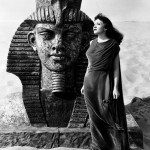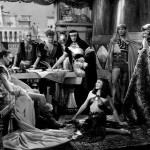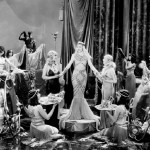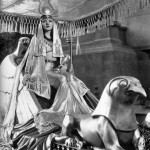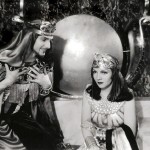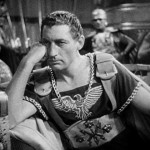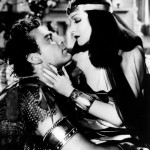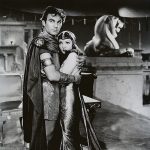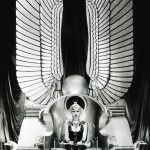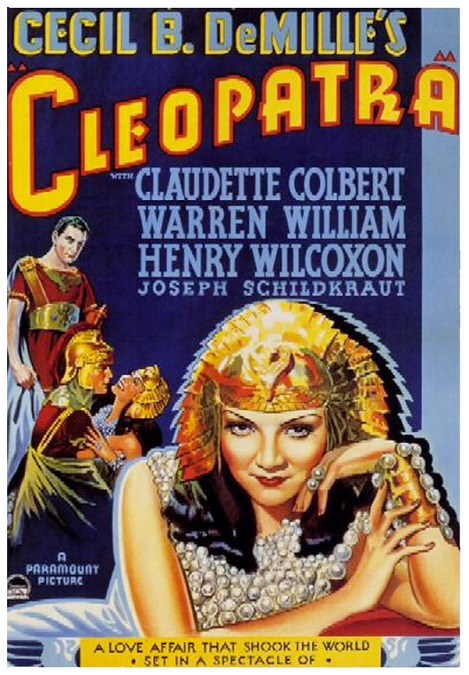
Cleopatra – 1934
This was a big movie. It was a huge Cecil B. DeMille epic that starred Claudette Colbert as Cleopatra, Warren William as Julius Cesar, and Henry Wilcoxon as Marc Antony. DeMille was famously known for the flamboyant spectacles of his films. It was beautifully and sumptuously designed with an opulent art deco style, and I think it would have been stunning as a color film.
Colbert, William and Wilcoxon all did a fine job in their respective roles. Colbert was beautiful, though if I am being honest, I have never liked her penciled-in eyebrows. They are frightening. And she didn’t look even remotely Egyptian. But putting that aside, she acted the part well enough. She had gravity and a sense of authority about her at the appropriate moments, though at other times she stopped being a queen and became a woman in love.
Wilcoxon was incredibly handsome and his acting was good. The scene that took place on Cleopatra’s barge, where she seduced Marc Antony with her exotic foods and dancing slaves, was a particularly fantastic sequence. Wilcoxon was able to portray a believable transition from anger to delight, and finally to lust, looking at the scantily clad dancing girls.
It was all a feast for the eyes and the wild and beautiful score by Rudolph Kopp helped propel the dancers into a frenzy of lust and passion. It was almost too much to take in. In a very sensuous sequence, Cleopatra has a team of hunky slaves in loincloths haul up a net from out of the sea. The net is carefully laid on the deck of the barge and when the ropes are released, we can finally see what has been “caught.” Six or seven naked women are in the net, each holding up an oyster shell filled with pearls and gems.
But then the whole scene was thrown into the realm of the bazar. A troupe of female dancers came out dressed in sexy leopard costumes, tails and all. They began having cat-fights on the deck, meowing, scratching and hissing at each other. They only stopped when a leopard tamer came out cracking his whip to force them into submission. Then they started doing cartwheels through three flaming hoops. Flaming hoops on a wooden barge…
And while we are on that subject, it is interesting to note that this movie was made in 1934. The Hays code was just beginning to take effect, allowing DeMille to be much more risqué than he could be in his later films. He showed more naked female flesh in this movie than I was expecting. Even Cleopatra, with her flamboyant wardrobe, seemed to be always showing her midriff, though we never once saw her belly-button.
Apparently no Roman man could resist Cleopatra’s exotic beauty and charms. Rome is out to conquer Egypt and Cleopatra’s way of keeping her throne is to seduce Cesar. But then he is assassinated because of his love affair with a foreign queen. Then the Roman Senate puts Marc Antony and Cesar’s nephew Octavian, played by Ian Keith, into positions of joint rulers.
Antony goes to conquer Egypt, but Cleopatra seduces him as well. The Roman army abandons him and he takes control of the Egyptian army. The fantastic battle sequence showed a surprising amount of blood and horrific death. But in the end Cleopatra, who has truly fallen for Antony, goes to Octavian to plead for his life. Thinking that she has betrayed him, Antony commits suicide. Cleopatra finds him and he dies in her arms. With the Roman army breaking down the palace doors, the Queen shoves a snake onto her breast and dies of its poison.
The film was huge and grand. It was well acted and had a good story. OK, so we threw reality out the window for a bit, but that was OK, and not entirely unexpected. I just wish this film could have been made in color. I guess I’ll just have to wait for Cleopatra, the 1963 Best Picture nominee with Elizabeth Taylor and Richard Burton.
